Baixi Sun
GFormer: Accelerating Large Language Models with Optimized Transformers on Gaudi Processors
Dec 19, 2024



Abstract:Heterogeneous hardware like Gaudi processor has been developed to enhance computations, especially matrix operations for Transformer-based large language models (LLMs) for generative AI tasks. However, our analysis indicates that Transformers are not fully optimized on such emerging hardware, primarily due to inadequate optimizations in non-matrix computational kernels like Softmax and in heterogeneous resource utilization, particularly when processing long sequences. To address these issues, we propose an integrated approach (called GFormer) that merges sparse and linear attention mechanisms. GFormer aims to maximize the computational capabilities of the Gaudi processor's Matrix Multiplication Engine (MME) and Tensor Processing Cores (TPC) without compromising model quality. GFormer includes a windowed self-attention kernel and an efficient outer product kernel for causal linear attention, aiming to optimize LLM inference on Gaudi processors. Evaluation shows that GFormer significantly improves efficiency and model performance across various tasks on the Gaudi processor and outperforms state-of-the-art GPUs.
SDP4Bit: Toward 4-bit Communication Quantization in Sharded Data Parallelism for LLM Training
Oct 20, 2024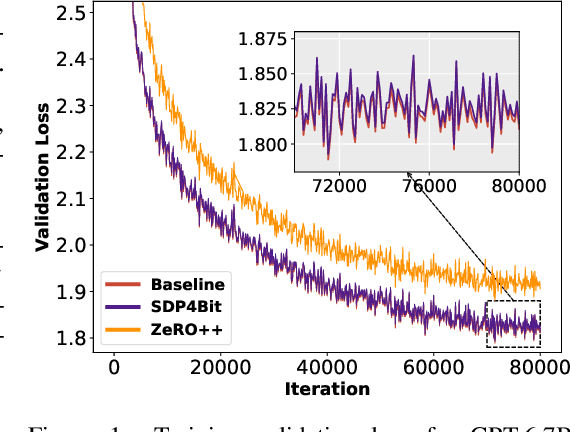

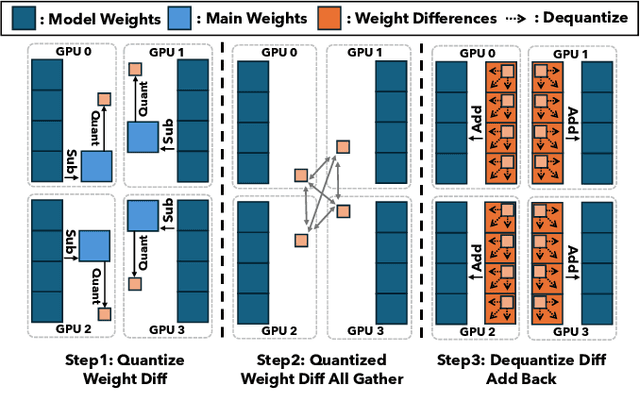

Abstract:Recent years have witnessed a clear trend towards language models with an ever-increasing number of parameters, as well as the growing training overhead and memory usage. Distributed training, particularly through Sharded Data Parallelism (ShardedDP) which partitions optimizer states among workers, has emerged as a crucial technique to mitigate training time and memory usage. Yet, a major challenge in the scalability of ShardedDP is the intensive communication of weights and gradients. While compression techniques can alleviate this issue, they often result in worse accuracy. Driven by this limitation, we propose SDP4Bit (Toward 4Bit Communication Quantization in Sharded Data Parallelism for LLM Training), which effectively reduces the communication of weights and gradients to nearly 4 bits via two novel techniques: quantization on weight differences, and two-level gradient smooth quantization. Furthermore, SDP4Bit presents an algorithm-system co-design with runtime optimization to minimize the computation overhead of compression. In addition to the theoretical guarantees of convergence, we empirically evaluate the accuracy of SDP4Bit on the pre-training of GPT models with up to 6.7 billion parameters, and the results demonstrate a negligible impact on training loss. Furthermore, speed experiments show that SDP4Bit achieves up to 4.08$\times$ speedup in end-to-end throughput on a scale of 128 GPUs.
FastCLIP: A Suite of Optimization Techniques to Accelerate CLIP Training with Limited Resources
Jul 01, 2024



Abstract:Existing studies of training state-of-the-art Contrastive Language-Image Pretraining (CLIP) models on large-scale data involve hundreds of or even thousands of GPUs due to the requirement of a large batch size. However, such a large amount of resources is not accessible to most people. While advanced compositional optimization techniques for optimizing global contrastive losses have been demonstrated effective for removing the requirement of large batch size, their performance on large-scale data remains underexplored and not optimized. To bridge the gap, this paper explores several aspects of CLIP training with limited resources (e.g., up to tens of GPUs). First, we introduce FastCLIP, a general CLIP training framework built on advanced compositional optimization techniques while designed and optimized for the distributed setting. Our framework is equipped with an efficient gradient reduction strategy to reduce communication overhead. Second, to further boost training efficiency, we investigate three components of the framework from an optimization perspective: the schedule of the inner learning rate, the update rules of the temperature parameter and the model parameters, respectively. Experiments on different strategies for each component shed light on how to conduct CLIP training more efficiently. Finally, we benchmark the performance of FastCLIP and the state-of-the-art training baseline (OpenCLIP) on different compute scales up to 32 GPUs on 8 nodes, and three data scales ranging from 2.7 million, 9.1 million to 315 million image-text pairs to demonstrate the significant improvement of FastCLIP in the resource-limited setting. We release the code of FastCLIP at https://github.com/Optimization-AI/fast_clip .
Benchmarking and In-depth Performance Study of Large Language Models on Habana Gaudi Processors
Sep 29, 2023Abstract:Transformer models have achieved remarkable success in various machine learning tasks but suffer from high computational complexity and resource requirements. The quadratic complexity of the self-attention mechanism further exacerbates these challenges when dealing with long sequences and large datasets. Specialized AI hardware accelerators, such as the Habana GAUDI architecture, offer a promising solution to tackle these issues. GAUDI features a Matrix Multiplication Engine (MME) and a cluster of fully programmable Tensor Processing Cores (TPC). This paper explores the untapped potential of using GAUDI processors to accelerate Transformer-based models, addressing key challenges in the process. Firstly, we provide a comprehensive performance comparison between the MME and TPC components, illuminating their relative strengths and weaknesses. Secondly, we explore strategies to optimize MME and TPC utilization, offering practical insights to enhance computational efficiency. Thirdly, we evaluate the performance of Transformers on GAUDI, particularly in handling long sequences and uncovering performance bottlenecks. Lastly, we evaluate the end-to-end performance of two Transformer-based large language models (LLM) on GAUDI. The contributions of this work encompass practical insights for practitioners and researchers alike. We delve into GAUDI's capabilities for Transformers through systematic profiling, analysis, and optimization exploration. Our study bridges a research gap and offers a roadmap for optimizing Transformer-based model training on the GAUDI architecture.
HEAT: A Highly Efficient and Affordable Training System for Collaborative Filtering Based Recommendation on CPUs
May 03, 2023



Abstract:Collaborative filtering (CF) has been proven to be one of the most effective techniques for recommendation. Among all CF approaches, SimpleX is the state-of-the-art method that adopts a novel loss function and a proper number of negative samples. However, there is no work that optimizes SimpleX on multi-core CPUs, leading to limited performance. To this end, we perform an in-depth profiling and analysis of existing SimpleX implementations and identify their performance bottlenecks including (1) irregular memory accesses, (2) unnecessary memory copies, and (3) redundant computations. To address these issues, we propose an efficient CF training system (called HEAT) that fully enables the multi-level caching and multi-threading capabilities of modern CPUs. Specifically, the optimization of HEAT is threefold: (1) It tiles the embedding matrix to increase data locality and reduce cache misses (thus reduces read latency); (2) It optimizes stochastic gradient descent (SGD) with sampling by parallelizing vector products instead of matrix-matrix multiplications, in particular the similarity computation therein, to avoid memory copies for matrix data preparation; and (3) It aggressively reuses intermediate results from the forward phase in the backward phase to alleviate redundant computation. Evaluation on five widely used datasets with both x86- and ARM-architecture processors shows that HEAT achieves up to 45.2X speedup over existing CPU solution and 4.5X speedup and 7.9X cost reduction in Cloud over existing GPU solution with NVIDIA V100 GPU.
SOLAR: A Highly Optimized Data Loading Framework for Distributed Training of CNN-based Scientific Surrogates
Nov 04, 2022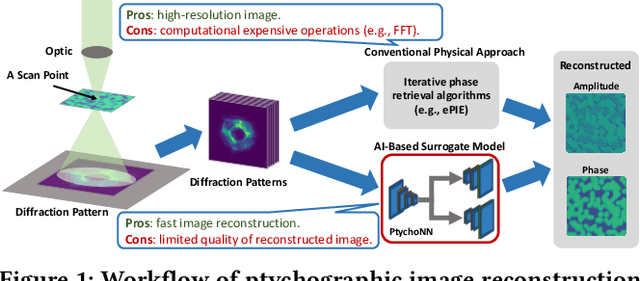
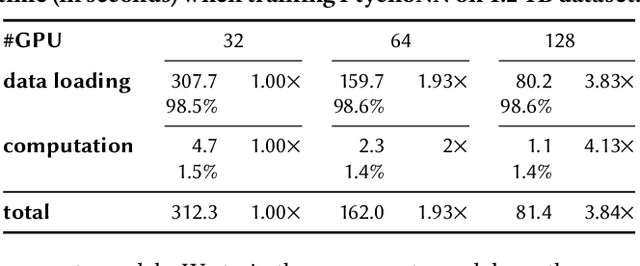
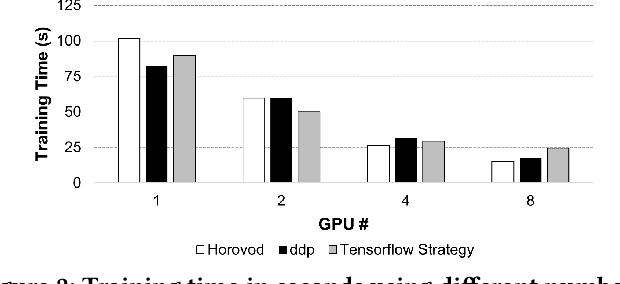
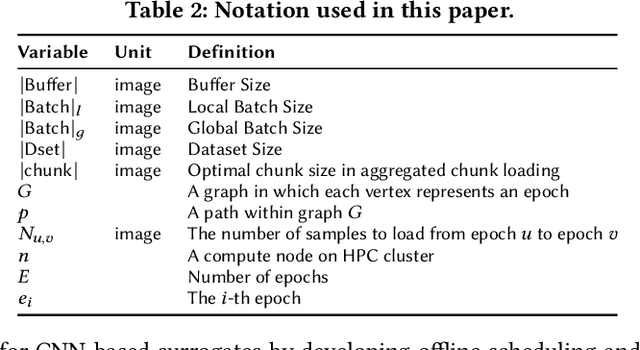
Abstract:CNN-based surrogates have become prevalent in scientific applications to replace conventional time-consuming physical approaches. Although these surrogates can yield satisfactory results with significantly lower computation costs over small training datasets, our benchmarking results show that data-loading overhead becomes the major performance bottleneck when training surrogates with large datasets. In practice, surrogates are usually trained with high-resolution scientific data, which can easily reach the terabyte scale. Several state-of-the-art data loaders are proposed to improve the loading throughput in general CNN training; however, they are sub-optimal when applied to the surrogate training. In this work, we propose SOLAR, a surrogate data loader, that can ultimately increase loading throughput during the training. It leverages our three key observations during the benchmarking and contains three novel designs. Specifically, SOLAR first generates a pre-determined shuffled index list and accordingly optimizes the global access order and the buffer eviction scheme to maximize the data reuse and the buffer hit rate. It then proposes a tradeoff between lightweight computational imbalance and heavyweight loading workload imbalance to speed up the overall training. It finally optimizes its data access pattern with HDF5 to achieve a better parallel I/O throughput. Our evaluation with three scientific surrogates and 32 GPUs illustrates that SOLAR can achieve up to 24.4X speedup over PyTorch Data Loader and 3.52X speedup over state-of-the-art data loaders.
 Add to Chrome
Add to Chrome Add to Firefox
Add to Firefox Add to Edge
Add to Edge